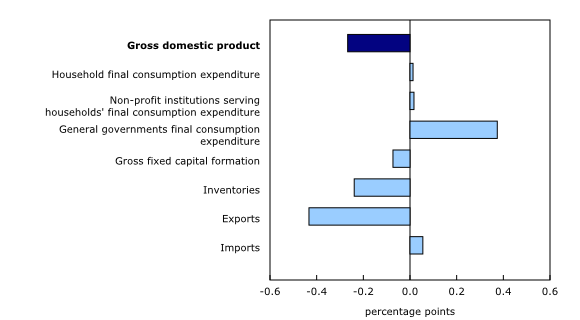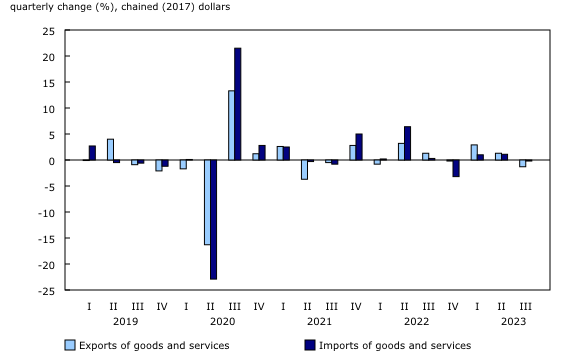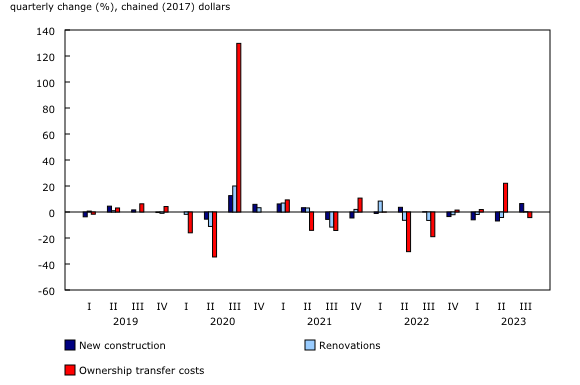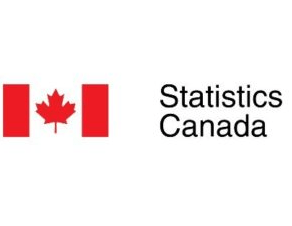Real gross domestic product (GDP) declined 0.3% in the third quarter, following a 0.3% increase in the second quarter. The decrease in international exports and slower inventory accumulation were partially offset by increases in government spending and housing investment. Final domestic demand increased 0.3%, following a similar increase in the second quarter.
Chart 1
Real gross domestic product and final domestic demand

Chart 2
Contributions to percentage change in real gross domestic product, third quarter of 2023

Lower exports led the decline in gross domestic product
Exports of goods and services fell 1.3% in the third quarter after increasing 1.3% in the second quarter. The leading contributor to the decrease was refined petroleum energy products, which dropped 25.4% in the third quarter after rising 23.9% in the second quarter.
Chart 3
Volumes of exports and imports

Imports of goods and services edged down 0.2% in the third quarter, following a 1.1% increase in the second quarter. The decrease in imports was led by declines in clothing, footwear and textile products, transportation services, and electronic and electrical equipment and parts. These declines were moderated by increased imports of passenger cars and light trucks as well as travel services.
Inventories accumulate at slowest pace in two years
Slower inventory accumulation in the third quarter applied downward pressure on GDP growth. This was the smallest buildup of inventories since the third quarter of 2021.
Among industries, manufacturers recorded a withdrawal in inventories in the third quarter of 2023 after six consecutive quarters of accumulations. Non-durable manufactured goods posted the largest quarterly withdrawal in inventories since the fourth quarter of 2010, while wholesale inventories withdrew for the first time since the first quarter of 2022. In contrast, retail inventories grew in the third quarter of 2023, primarily due to a buildup in motor vehicles inventories, which more than offset the inventory withdrawals in the manufacturing and wholesale sectors.
New housing construction increases for first time since early 2022
After five consecutive quarterly declines, housing investment increased 2.0% in the third quarter of 2023. An increase in new construction (+6.5%) was partly offset by a decline in ownership transfer costs (-4.3%), which represents resale activity.
Chart 4
Housing investment

Apartment construction had the greatest impact on new construction; costs related to new construction, such as taxes and closing costs upon ownership change, also contributed to new construction investment. The increase in new construction was observed across all provinces and the Northwest Territories, with the Atlantic provinces posting the largest increases.
Household spending remains flat
Household expenditure was unchanged in the third quarter, following a flat second quarter. Durable goods increased 1.0%, led by new trucks, vans and sport utility vehicles (+1.9%), as supply chain issues and manufacturing delays eased and inventories were replenished.
Higher household spending on services (+0.3%) was largely offset by declines in spending on non-durable (-0.4%) and semi-durable (-2.8%) goods.
Business investment in non-residential construction and machinery and equipment declines
Business investment in non-residential structures fell 2.0% in the third quarter, led by decreased spending on engineering structures (-2.5%), which declined for the first time since the first quarter of 2022. The near completion of the Kitimat liquified natural gas project contributed to the decline.
Business spending on machinery and equipment fell 3.8% in the third quarter of 2023, following a 4.4% increase in the second quarter. The decrease was led by lower spending on aircraft and other transportation equipment, after a strong growth in aircraft and ships in the second quarter.
Business spending on intellectual property products edged down 0.3% in the third quarter. The decline was led by lower spending on software (-0.8%). However, spending on mineral exploration (+2.8%) nearly offset the decline.
Gross domestic product implicit prices rise on higher export prices
Largely driven by increased prices of exported items (+3.9%), including crude oil and crude bitumen, the GDP implicit price rose 1.8% in the third quarter. The terms of trade, which is the ratio of the price of exports to the price of imports, grew 4.0%, the first increase since the second quarter of 2022.
Chart 5
Gross domestic product price indexes, selected components

The implicit price of household final consumption rose 0.8% in the third quarter of 2023, following a 0.9% increase in the second quarter. Higher prices of non-durable goods and services led the increase. The price index for household final consumption expenditure (excluding food and energy) rose 0.5% in the third quarter, the smallest increase since the first quarter of 2021.
Compensation of employees rises
Compensation of employees rose 1.3% on a nominal basis in the third quarter of 2023, as average earnings and employment increased. Wages and salaries in services-producing industries rose 1.7%, while those in goods-producing industries were flat (+0.0%). The top industry contributors to overall wage growth were professional and personal services, health services, and federal public administration including military services.
Map 1
Compensation of employees, quarter-to-quarter % change, seasonally adjusted data

Prince Edward Island (+3.2%) and Newfoundland and Labrador (+2.8%) had the largest increases in compensation of employees in the third quarter, followed by British Columbia (+1.9%). After relatively low growth in the previous quarter, compensation of employees in the Northwest Territories and Nunavut (-1.3%) decreased.
Household saving rate increases
Household net saving (in nominal terms) increased in the third quarter, as a modest gain in household disposable income (+1.0%) surpassed the rise in household spending (+0.8%). Softening labour market conditions and weaker financial market gains relative to the second quarter were counteracted by higher government transfers, which were mainly due to the introduction of the Grocery Rebate on July 5, 2023.
Compensation of employees increased by 1.3% in the third quarter, led by higher property income (+2.9%). Meanwhile, government transfers to households grew by 0.7%, representing the first quarterly increase since the fourth quarter of 2022.
Consequently, the household saving rate reached 5.1% in the third quarter of 2023, up from 4.7% in the second quarter. The household saving rate is aggregated across all income brackets; in general, saving rates are greater in higher income brackets.
Gross operating surplus bounces back
In the third quarter, gross operating surplus rose 2.3% after declining in each of the previous four quarters. Higher gross operating surplus for non-financial corporations was partly offset by a decline in that of financial corporations.
Incomes for the non-financial sector in the third quarter were boosted by higher prices for crude oil and refined petroleum products. Increases in incomes across the entire motor vehicle supply chain also contributed to higher corporate incomes, reflected by increased profits, despite declines in motor vehicle sales in the first two months of the quarter.
Gross operating surplus for financial corporations continued to decline in the third quarter owing to higher insurance claims. Narrowing net interest margins among chartered banks due to the fast pace of central bank policy rate increases also contributed to the decline.






